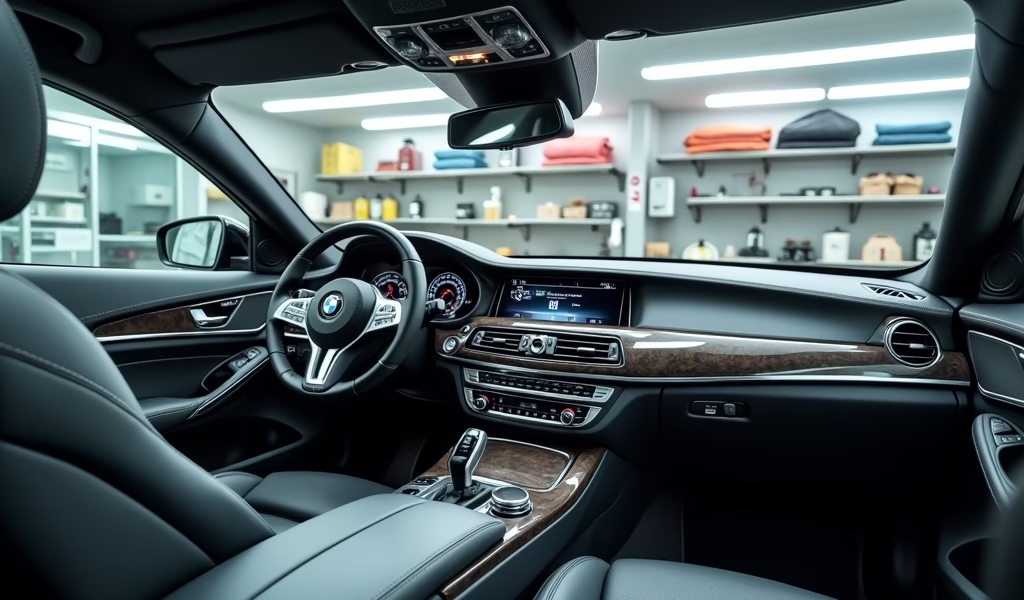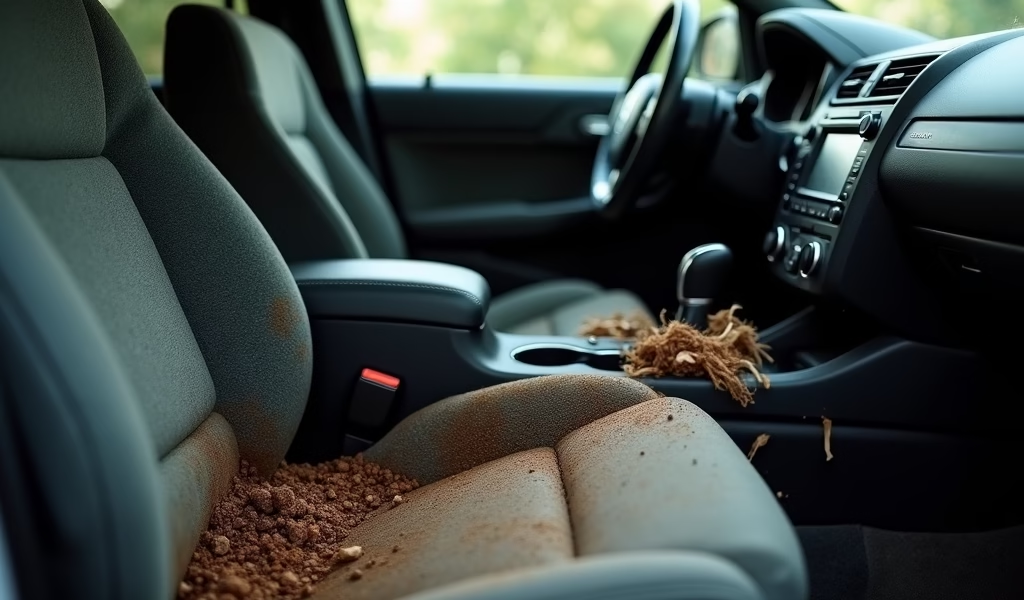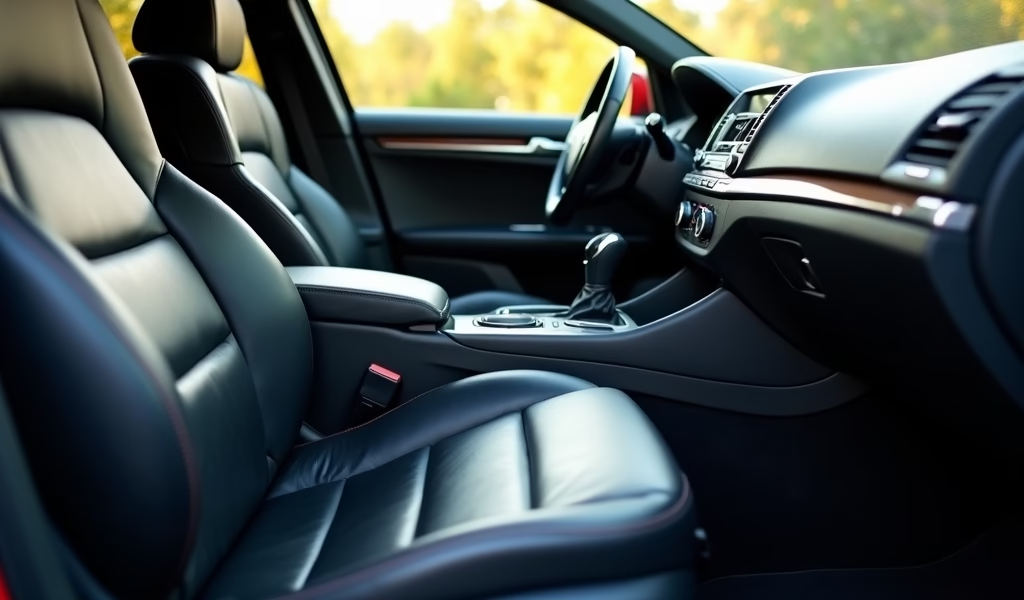Overview
This article provides five professional car interior cleaning techniques covering dashboard detailing, upholstery care, streak-free glass cleaning, stain removal, and odor elimination strategies. It emphasizes that regular interior cleaning not only creates a more pleasant driving experience but also maintains vehicle value, prevents material damage, and eliminates health hazards from bacteria and allergens.
Table of Contents
- Introduction to Car Interior Cleaning
- Why Regular Interior Cleaning Matters
- Pro Hack #1: Dashboard and Console Detailing
- Pro Hack #2: Upholstery and Fabric Care
- Pro Hack #3: Glass and Mirror Perfection
- Pro Hack #4: Tough Stain Removal Techniques
- Pro Hack #5: Odor Elimination Strategies
- Maintaining Your Clean Car Interior
- Conclusion
- Frequently Asked Questions
Introduction to Car Interior Cleaning
When it comes to car interior cleaning tips, there’s a world of difference between a quick vacuum and a truly pristine cabin. As someone who’s spent decades under hoods and inside passenger compartments, I can tell you that the interior of your vehicle deserves just as much attention as that shiny exterior. Your car’s cabin is essentially your second living room—a space where you likely spend hours each week.
The average American spends nearly 300 hours per year in their car. That’s a lot of coffee spills, food crumbs, dust accumulation, and general wear and tear. A clean interior not only makes your driving experience more pleasant but also maintains your vehicle’s value and can prevent long-term damage to surfaces and materials.
In this comprehensive guide, I’ll share five professional car interior cleaning tips that go beyond the basics. These aren’t just any tips—they’re the same techniques used in professional car detailing services that typically cost hundreds of dollars. With some elbow grease and the right approach, you can achieve remarkable results right in your driveway.
Why Regular Interior Cleaning Matters
Before diving into specific car interior cleaning tips, let’s understand why this maintenance task deserves your attention. Beyond the obvious aesthetic benefits, regular interior cleaning serves several crucial purposes that directly impact your driving experience and vehicle longevity.
First, consistent cleaning prevents premature wear. Dirt and debris act like tiny sandpaper particles when trapped between fabric fibers or pressed against surfaces. Over time, this accelerates wear and can permanently damage materials. According to a study by AutoTrader, vehicles with well-maintained interiors can retain up to 10% more value when it’s time to sell or trade in.
Additionally, a clean interior contributes to better health. The enclosed environment of your car cabin can harbor allergens, bacteria, and mold—especially in areas with high humidity. Research from the University of Nottingham found that the average car interior contains approximately 700 bacterial strains. Regular cleaning reduces these potential health hazards, creating a safer environment for you and your passengers.
Finally, there’s the undeniable psychological benefit. A clean, organized car interior reduces stress and creates a more enjoyable driving experience. It’s similar to how a tidy home can improve your mood and mental clarity. Your vehicle represents a significant investment—maintaining its interior properly simply makes good financial and practical sense as part of your overall essential car maintenance routine.

Pro Hack #1: Dashboard and Console Detailing
Your dashboard and center console collect more dust and fingerprints than nearly any other interior surface. These areas are constantly exposed to sunlight, which can accelerate deterioration if not properly maintained. Here’s my professional approach to keeping these surfaces pristine:
The Right Tools for Dashboard Cleaning
Start with the right arsenal. You’ll need:
- Microfiber cloths (at least 3-4)
- A small detailing brush (an old toothbrush works in a pinch)
- Compressed air (canned air or a small compressor)
- A quality water-based protectant (avoid silicone for long-term durability)
- Cotton swabs for tight spaces
Begin by thoroughly dusting the entire area. Use compressed air to blast dust out of vents, crevices, and hard-to-reach places. This step is crucial—if you skip it and go straight to wiping, you’ll just push dust around and potentially scratch delicate surfaces.
For vinyl and plastic surfaces, I recommend using a slightly damp microfiber cloth with a tiny amount of mild cleaner specifically formulated for automotive interiors. The key word is “slightly”—excess moisture can seep into electronic components and cause damage that’s expensive to repair.
For those intricate buttons and knobs, use a detailing brush to gently dislodge dust before wiping. Cotton swabs dampened with cleaner (and then wrung almost dry) work wonders for cleaning around switches and in tight crevices. Always follow with a dry microfiber cloth to prevent streaking and water spots.
Protecting Your Dashboard
After cleaning, apply a UV-protective coating to prevent cracking and fading. Quality matters here—opt for water-based protectants rather than the cheap silicone-based products that leave a greasy finish and attract dust. Apply the protectant to a cloth first, never directly to the surface, to prevent overspray onto glass and other areas where it doesn’t belong.
For screens and digital displays, use cleaners specifically designed for electronics. Standard household glass cleaners often contain ammonia, which can damage anti-glare coatings. A microfiber cloth slightly dampened with distilled water usually suffices for routine cleaning of these sensitive components.
Pro Hack #2: Upholstery and Fabric Care
Vehicle upholstery absorbs everything from spilled coffee to body oils and perspiration. Different materials require different cleaning approaches, but the principles remain similar. Here’s how to breathe new life into your car’s seating surfaces:
Fabric Upholstery Cleaning
For cloth seats and fabric surfaces, start with a thorough vacuum using upholstery attachments. Work from top to bottom, using crevice tools for seams and tight spots. Don’t rush this step—thoroughness here will make the actual cleaning much more effective.
For general fabric cleaning, I recommend using a foaming upholstery cleaner. These products lift dirt from fibers rather than pushing it deeper in. Apply a modest amount to a small area, then agitate gently with a soft-bristled brush using circular motions. This creates foam that encapsulates dirt particles.
For stubborn stains on fabric, create a solution of one part white vinegar to four parts warm water with a drop of dish soap. Apply with a clean microfiber cloth, working from the outside of the stain inward. The technique matters—blot, don’t rub, to prevent spreading the stain and damaging fibers.
Always complete the process with a thorough extraction. If you don’t own a wet/dry vacuum or extractor, you can simulate this by pressing clean, dry microfiber towels firmly against the dampened upholstery to absorb moisture and lifted dirt. This step is crucial to prevent mold and mildew growth in the padding beneath.
Leather and Vinyl Care
Leather requires a completely different approach. First, identify whether your seats are genuine leather, leatherette, or vinyl, as each requires slightly different care. For genuine leather, use a pH-balanced leather cleaner to avoid stripping natural oils.
Apply the cleaner to a microfiber cloth rather than directly to the leather. Work in small sections, using gentle circular motions. For seams and perforations, use a soft brush to work the cleaner in without saturating the material. Follow immediately with a clean, dry microfiber cloth to remove residue.
The secret to long-lasting leather is proper conditioning after cleaning. A quality leather conditioner replenishes natural oils and creates a protective barrier against UV damage and wear. Apply sparingly—too much conditioner can make surfaces slippery or cause premature wear by softening the leather excessively. Always perform a spot test in an inconspicuous area first.
Pro Hack #3: Glass and Mirror Perfection
Nothing diminishes the impression of a clean car interior like streaky windows and mirrors. Achieving truly spotless glass requires more technique than elbow grease. Here’s my foolproof method for crystal-clear results:
The Two-Towel Technique
The professional secret to streak-free glass is using two separate microfiber towels—one for cleaning and one dedicated solely to final polishing. This prevents redepositing cleaner residue, which causes those frustrating streaks.
Start with a quality automotive glass cleaner that’s ammonia-free. Ammonia can damage tinting films and electronic components in modern windows. Spray a modest amount onto your first microfiber cloth, never directly onto the glass. This prevents overspray from damaging surrounding surfaces and reduces the amount of product that can seep into door panels.
Clean in a specific pattern—I recommend horizontal strokes for the exterior glass and vertical strokes for interior surfaces. This technique makes it immediately obvious which side any remaining streaks are on. For hard-to-reach areas like the bottom of the windshield, a microfiber cloth wrapped around a long, flat tool (like a ruler) works wonderfully.
After cleaning, immediately use your second, completely dry microfiber cloth to polish the surface to a perfect finish. The key is using a cloth that’s never been exposed to cleaning products—this ensures it absorbs residue rather than spreading it around. For the ultimate finish, give the glass a final buff with a clean section of the second cloth.
Addressing Problem Areas
For stubborn issues like water spots or hazy film from smoking, you’ll need a more aggressive approach. A 50/50 mixture of distilled white vinegar and distilled water works wonders for mineral deposits without damaging surfaces. For smokers’ film, a small amount of isopropyl alcohol (70%) on a microfiber cloth cuts through the residue effectively.
Don’t forget the exterior side of the windows while you’re working on the interior. Many enthusiasts swear by using a clay bar on exterior glass to remove embedded contaminants before cleaning. This extra step creates a surface so smooth that water beads and slides off more readily, improving visibility during rain.
Pro Hack #4: Tough Stain Removal Techniques
Even the most careful drivers eventually face challenging stains in their car’s interior. These specialized car interior cleaning tips for common tough stains can save your upholstery from permanent damage:
Coffee and Beverage Stains
These acidic stains set quickly if not addressed immediately. For fresh spills, blot (don’t rub) with an absorbent cloth to remove as much liquid as possible. For set-in stains on fabric, create a paste of baking soda and water, apply it to the stain, and let it dry completely before vacuuming.
For more stubborn beverage stains, club soda works remarkably well on both fabric and carpet. The carbonation helps lift the stain while the slight alkalinity neutralizes acidic components. Apply, let it fizz for a minute, then blot with a clean microfiber cloth. Repeat as necessary, working patiently rather than aggressively.
Ink and Dye Marks
Ink stains are particularly challenging but not impossible. For fabric upholstery, a small amount of rubbing alcohol on a cotton swab can work wonders. Test in an inconspicuous area first, then gently dab (never rub) the affected area, working from the outside in.
For leather, ink removal requires extreme caution to avoid damaging the finish. Use a leather-specific ink remover and follow the manufacturer’s instructions precisely. If you don’t have a specialized product, a small amount of non-acetone nail polish remover on a cotton swab can work, but only as a last resort and after testing in a hidden area.
Oil and Grease
Oil-based stains require an approach that breaks down the oils before cleaning. For fabric, sprinkle cornstarch or baby powder liberally on the stain and let it sit for several hours (overnight if possible) to absorb the oil. Vacuum thoroughly, then treat any remaining discoloration with a mixture of dish soap and warm water, applied with a soft brush in gentle circular motions.
For leather and vinyl, oil stains can often be addressed with a paste made from cream of tartar and lemon juice. Apply the paste, let it sit for 30 minutes, then wipe clean with a damp cloth. This natural acidic combination cuts through oils without damaging most leather finishes, but always test in an inconspicuous area first.

Pro Hack #5: Odor Elimination Strategies
Lingering odors can ruin even the most visually clean interior. Unlike home environments, cars present unique challenges for odor elimination due to their enclosed nature and variety of materials. Here’s how to ensure your car smells as clean as it looks:
Finding the Source
Effective odor elimination begins with identifying the source rather than masking it. Check obvious locations first: floor mats, under seats, seat crevices, and the headliner. Don’t forget less obvious spots like air vents, the cabin filter, and even the trunk, as odors can permeate throughout the vehicle.
For general mustiness, the culprit is often moisture trapped in carpets or under mats. Remove floor mats and check for dampness. If you find wet areas, use towels to absorb as much moisture as possible, then use a wet/dry vacuum to extract remaining moisture. A handheld moisture meter (available at most hardware stores) can help identify problem areas that aren’t obvious to the touch.
Deep Cleaning for Odor Removal
For persistent odors in fabric and carpet, baking soda is your best friend. Sprinkle it liberally over all fabric surfaces, gently work it in with a soft brush, and let it sit overnight. The baking soda absorbs odors rather than masking them. Vacuum thoroughly the next day using a shop vac with HEPA filtration if available.
For smoke odors, which are particularly challenging, you’ll need to clean all hard surfaces with a vinegar solution (one part vinegar to four parts water) and possibly use an ozone generator for severe cases. If using ozone treatment, note that this should be done by professionals or with extreme caution, as ozone can damage certain interior materials and is harmful to breathe.
Don’t neglect your vehicle’s HVAC system when addressing odors. Bacterial growth in evaporators and ducts is a common source of that “old car smell.” Use a quality HVAC cleaner that foams and coats the entire system. Turn your AC to maximum with recirculation on, spray the cleaner into the intake (usually located at the base of the windshield), and let the system run for 15 minutes with doors closed.
For a natural ongoing odor prevention strategy, small cotton pouches filled with activated charcoal placed under seats absorb odors without adding artificial fragrances. These can be “recharged” monthly by placing them in direct sunlight for a few hours.
Maintaining Your Clean Car Interior
After investing time in a thorough interior cleaning, establishing good habits will help maintain that fresh, clean feeling much longer. This is where preventive car maintenance practices really pay off in the long run.
Consider installing a set of high-quality all-weather floor mats that contain spills and debris. These mats are significantly easier to remove and clean than trying to extract stains from your car’s carpeting. For fabric protection, apply a quality fabric guard after cleaning to repel future stains.
Establish a quick weekly maintenance routine: remove trash, wipe down frequently touched surfaces with a microfiber cloth, and vacuum seats and carpets. This 15-minute investment prevents buildup that requires deeper cleaning later. Keep a small cleaning kit in your trunk for immediate attention to spills before they set and become stains.
For those with children or pets, consider keeping a dedicated hand vacuum in the car, along with a container of cleaning wipes suitable for your interior materials. Addressing messes immediately prevents them from becoming permanent fixtures in your vehicle’s interior.
Conclusion
Mastering these car interior cleaning tips doesn’t just result in a vehicle that looks better—it creates a healthier, more pleasant driving environment and preserves your car’s value. The professional hacks we’ve explored go beyond surface cleaning to address the specific challenges vehicle interiors face: from UV damage to deep-set stains and stubborn odors.
Remember that consistency is key. Rather than waiting until your car interior becomes noticeably dirty, incorporating regular maintenance into your routine prevents problems before they require intensive intervention. Even five minutes of attention several times a week can maintain most of the benefits of a deep clean.
By approaching interior cleaning methodically—working from top to bottom and dry to wet—you’ll achieve more efficient results with less effort. The professional techniques shared here represent years of hands-on experience and will serve you well whether you’re maintaining a family minivan or a luxury sedan.
Your car is more than just transportation—it’s a personal space where you likely spend significant time. Treating it with the same care you would your home not only makes practical sense but enhances your daily driving experience. With these professional car interior cleaning tips in your arsenal, you’re well-equipped to maintain a vehicle interior that looks, feels, and smells showroom-fresh for years to come.
Frequently Asked Questions
How often should I deep clean my car’s interior?
For average use, perform a thorough interior cleaning every 3 months. Increase frequency to monthly if you have children, pets, or frequently eat in your vehicle.
What’s the best way to clean leather seats without damaging them?
Use a pH-neutral leather cleaner applied to a microfiber cloth, never directly to the leather. Always follow with a leather conditioner to replace natural oils and prevent drying and cracking.
Can I use household cleaners on my car’s interior surfaces?
Most household cleaners are too harsh for automotive surfaces and can cause damage. Stick to products specifically formulated for auto interiors to avoid discoloration or deterioration of materials.
How do I remove pet hair effectively from car upholstery?
Use a rubber pet hair removal brush or wear slightly dampened rubber gloves and run your hands over the surfaces. For stubborn hair, a spray bottle with water and fabric softener followed by a squeegee works remarkably well.
What’s the quickest way to eliminate smoke smell from a car interior?
Replace the cabin air filter, thoroughly clean all hard surfaces with a vinegar solution, and treat fabrics with baking soda overnight. For severe cases, professional ozone treatment may be necessary.

